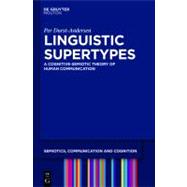
Note: Supplemental materials are not guaranteed with Rental or Used book purchases.
Purchase Benefits
Looking to rent a book? Rent Linguistic Supertypes [ISBN: 9783110253139] for the semester, quarter, and short term or search our site for other textbooks by Durst-andersen, Per. Renting a textbook can save you up to 90% from the cost of buying.
| Preface | p. ix |
| Language and beyond | |
| Language and situations | p. 3 |
| Preliminary remarks | p. 3 |
| Previous approaches to situation and verb typology | p. 3 |
| The present approach | p. 5 |
| Aspectual types | p. 14 |
| Syntactic types | p. 20 |
| Summary | p. 27 |
| Language and perception | p. 29 |
| Preliminary remarks | p. 29 |
| ôNewö linguistic data | p. 31 |
| Naming strategies and lexicalization patterns | p. 39 |
| Descriptions of activities based on postures | p. 44 |
| Descriptions of actions involving a location | p. 48 |
| Framing strategies and the ordering of linguistic elements | p. 53 |
| Results from eye-tracking studies and brain scan tests | p. 61 |
| Language and cognition | p. 66 |
| Preliminary remarks | p. 66 |
| Introducing the event vs. process distinction | p. 67 |
| The mental model of events and its instruction | p. 68 |
| Linguistic evidence for the three psychological dimensions | p. 74 |
| Firstness, secondness and thirdness | p. 77 |
| The mental model of processes and its instruction | p. 78 |
| Background knowledge of actions | p. 81 |
| From assimilation to accommodation in the human mind | p. 87 |
| Concluding remarks | p. 91 |
| Grammar and communication | |
| Grammar and pragmatics | p. 95 |
| Introduction | p. 95 |
| Grammar in communication | p. 96 |
| Product and consumer communication | p. 102 |
| The layered structure of imperatives | p. 110 |
| Towards a deeper understanding of indirect speech acts | p. 115 |
| The imperative frame analysis | p. 119 |
| Conclusions | p. 125 |
| Grammar and semiotics | p. 126 |
| Preliminary remarks | p. 126 |
| Introduction | p. 127 |
| The simple sign of nouns and verbs | p. 130 |
| The simple sign as an image-idea pair | p. 133 |
| Arbitrariness and motivatedness of the simple sign | p. 144 |
| The complex sign as a dynamic unit - an index | p. 147 |
| The semiotic function of grammar | p. 154 |
| Discussing icons, indexes and symbols | p. 160 |
| Conclusions | p. 163 |
| Language inside out | |
| From types to supertypes | p. 167 |
| The various typological trichotomies | p. 167 |
| Introducing the three linguistic supertypes | p. 174 |
| Supertypes and related issues | p. 179 |
| The basic voice of language | p. 184 |
| Introduction | p. 184 |
| Reality-oriented languages | p. 185 |
| Speaker-oriented languages | p. 200 |
| Hearer-oriented languages | p. 206 |
| Concluding remarks | p. 214 |
| Linguistic expansion | p. 216 |
| Introductory remarks | p. 216 |
| The expanding function of Russian aspect | p. 216 |
| The expanding function of Bulgarian mood | p. 223 |
| The expanding function of Danish tense | p. 227 |
| Recapitulating and concluding | p. 232 |
| The principal and secondary voice of language | p. 236 |
| Introduction | p. 236 |
| The principal and secondary voice of Russian | p. 238 |
| The principal and secondary voice of Bulgarian | p. 245 |
| The principal and secondary voice of Danish | p. 251 |
| Conclusions | p. 260 |
| Focusing summary | p. 261 |
| References | p. 267 |
| Definition list | p. 295 |
| Index | p. 307 |
| Table of Contents provided by Ingram. All Rights Reserved. |
The New copy of this book will include any supplemental materials advertised. Please check the title of the book to determine if it should include any access cards, study guides, lab manuals, CDs, etc.
The Used, Rental and eBook copies of this book are not guaranteed to include any supplemental materials. Typically, only the book itself is included. This is true even if the title states it includes any access cards, study guides, lab manuals, CDs, etc.